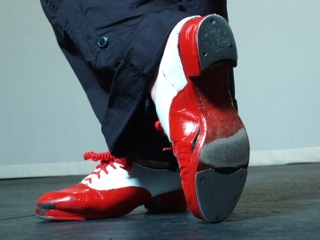
WITH COMPETITION SEASON WELL AND TRULY UNDER WAY
HERE ARE CHRISTINE DENNY’S (FROM TAPATAK OZ) TOP SEVEN TIPS FOR OUTSTANDING TAP ROUTINES IN YOUR COMPS
- Timing – you would be surprised how many competitors dance in and out of time with their music when performing a tap solo. I know this will seem obvious but you really must be exactly on the beat of your music when performing a tap routine otherwise the beats do not go with the music and it just sounds terrible. The same applies to tap groups which can often race way ahead of the music when you get on stage and have that extra adrenalin rush of performing. So – be aware of this and when you are rehearsing you must practice the routine flat out or otherwise you risk it all going very pear shaped on the day of the comp. If suddenly everyone is dancing at their full energy level and that has never happened in class before, the extra oomph can send you racing way ahead and out of time with the music! So – to avoid this, every member of the group must practice with full energy and personality in class.
- Speed Tap – carrying on from the comments above, it is remarkable that in an average speed tap section nearly 50 % of participants are unable to keep up with their music. So – make sure you choose the tempo of the routine well. Of course it should be challenging – it is a speed tap after all! But if by the week prior to the competition you can not comfortably and confidently perform the whole routine from start to finish perfectly in time with your music, then I suggest you ask your teacher to slow the music down a little. You can always increase the speed the following year when you have had a chance to practice a little more and gain the speed and confidence you need.
- Slow Tap – in your Tap Championship it is really important that your slow tap routine shows a total contrast to your speed. And I don’t just mean that you wear a different outfit that looks all flowy! You really need to give this routine a totally different style and personality, control all your beats and make sure they melt into the floor to give the routine that fluidity and smoothness that a slow tap requires. Often times the slow routine is tapped with exactly the same dynamics as the speed tap, so it sounds really bashed and forced! Remember that the idea of performing these two routines in a championship is to demonstrate your ability to vary your style, personality, dynamics and technique to match the contrasting music and choreography of your routines.
- Technique matches Style – I often find when adjudicating tap sections that there are very few competitors who have the whole package. I find some dancers are fantastic technicians with lovely lyrical sounding beats but they have not developed their performance skills and tend to have bad posture with little personality and showmanship. Then on the other side of the equation you have dancers who have very little tap technique but look fantastic, wowing the audience with their smile and style. This puts the adjudicator in the predicament of choosing what they are going to value more highly – the technique or the style! Both are very important. So your best bet is to make sure that you have equal amounts of both. If you know that one area of your performance is lacking then really focus on strengthening that aspect of your performance.
- Content – now this is a tricky one. If your routine is too difficult and you make a mess of it that won’t work in your favour. But on the other hand if it is too easy then you run the risk of being left behind no matter how well your perform it. So remember – a simple routine with little content that is performed brilliantly will have a hard time competing with a very technical and challenging routine that is also performed brilliantly by someone else. So you have to know your capabilities and pace yourself. This is often a difficult thing in group sections where some groups often have much greater rhythmic content and variation than others. Again – if your routine looks great, but is also challenging and polished rhythmically, then you are poised to appeal to all adjudicators – those with a passion for tap as well as those who are more focused on the visual aspects.
- Rhythm – again it sounds obvious but you must be sure of all your rhythms. The rhythm should flow out naturally blending with the music. So often this is not the case and it is really difficult to tell what the rhythms are meant to be. So make sure you secure all your rhythms with a good accent so the audience can follow what you are doing and it flows easily along with the music! And when working no a group, make sure that the accent really anchors all the rhythms so the synchronicity of the beats is spot on. Nothing sounds worse that a tap group with people not tapping together and a clever use of accent can really assist with this element. Add in a good dose of “light and shade”, so the rhythms are really pleasant and interesting to listen too and the rhythmic side of your performance will be polished and impressive.
- Attitude and Passion – my personal opinion is that Eisteddfods are a great way to perfect your performance skills and improve your technique, as your teacher can tailor make a routine to extend your personal abilities to their utmost. But at the end of the day you should always be competing with yourself and no one else. If you practiced solidly prior to the competition and then did your best on the day, then you have won – regardless of the official placings. And if you did not perform well on the day and know you didn’t do your best, but still win first place then you are justified in feeling a little disappointed. Competition is about pitting yourself against yourself– not anyone else! It is seeing what the best is you can achieve, with the talents you have been given, and the effort you have put in, on a given day. Perhaps your best was not judged to be as good as the winner’s best on the day – but that is life! We can’t all be the best at everything and what a boring place the world would be if we all liked the same thing. And remember – this is the arts and it is subjective! So look around and appreciate the opportunity to see what other dancers and dancing schools have to offer. If you like it – then you work towards becoming more like that. And if you don’t – then you applaud their efforts and continue on your merry way!! The idea is to become the best you can be and to have fun! Which brings me to passion. Nothing can beat a passionate performance, with every person on stage [ whether in a solo, duo or group situation] giving 100% energy and personality to the routine. If you look like you love what you are doing – the audience and the adjudicator will too. So really go for it, wear your proverbial heart on your sleeve. Show the joy, drama, melancholy or quirkiness etc in your routine and sell it to the people watching. You need to take them on an exciting journey for the entire performance. Tell them a story and get them involved and invested in what you are doing up on stage……..not invested in using your routine as an opportunity to go and buy a drink outside.
It all comes down to Passion. Preparation and Performance.
– Christine –
SO – GO GET ‘EM EVERYONE.
HAVE FUN AND ENJOY THE OPPORTUNITY TO PERFORM AND PERFECT ALL YOU HAVE BEEN WORKING ON.
For more info on Tapatak Oz please visit our website:
http://www.tapatakoz.com.au/testimonials.htm
Join us on Facebook here: http://www.facebook.com/#!/groups/tapatakoz/














Nora Stewart says:
Hi – Nice list! Could I suggest you add two more things:
1. Have great music for your routine that makes you smile
2. Listen to it
These two things will make most of the other on the list happen.
I dance Irish – sean nos style & set dancing.
Thanks for posting.
Nora
Georga says:
This is great! I tell my kids that they can’t have strong technique and no showmanship, because who wants cake with no icing! I will make all my kids read this article before our next eisteddfod! Thankyou!